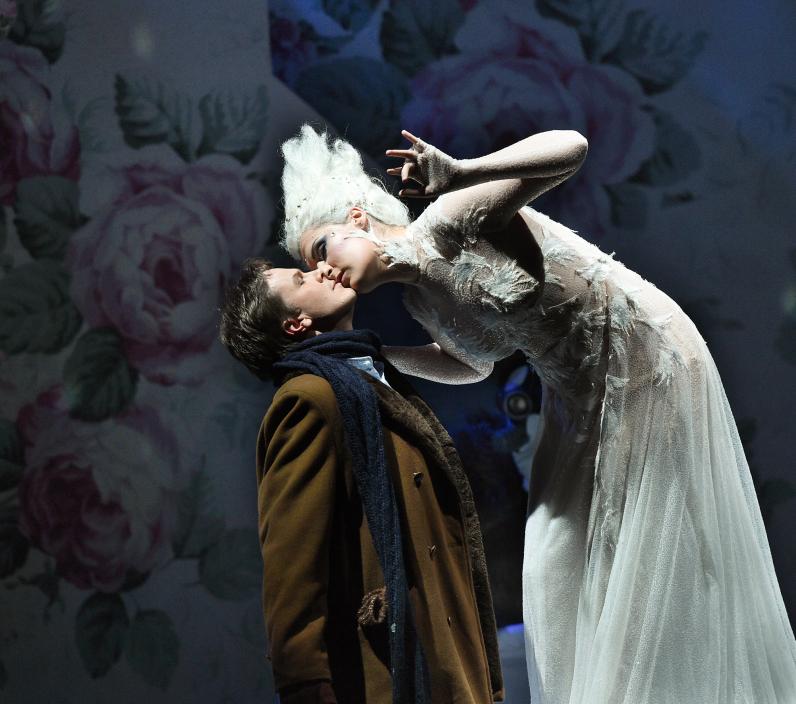

In a faraway land lives a fairytale queen, but not all is as it seems...
Cast
Snow Queen | Adela Zaharia |
|---|---|
Kay | Dmitri Vargin |
Gerda | Heidi Elisabeth Meier |
Flower Girl | Annika Kaschenz |
Crow | Florian Simson |
The Prince | Bryan Lopez Gonzalez |
Princess | Dimitra Kotidou |
Bandit Girl | Katharina von Bülow |
Reindeer | Lukasz Konieczny |
Grandmother/ Finnish Woman | Susan Maclean |
Clumsy Troll | Aïsha Tümmler |
Silly Troll | Conny Thimander |
Devil Troll | David Jerusalem |
Chorus | Students of the Robert Schumann Musikhochschule Düsseldorf and Actors from the Deutschen Oper am Rhein |
Orchestra | Altstadtherbst Orchester Düsseldorf |
| ... | |
Music | Marius Felix Lange |
|---|---|
Conductor | Ville Enckelmann |
Director | Johannes Schmid |
Sets | Tatjana Ivschina |
Lighting | Volker Weinhart |
Costumes | Tatjana Ivschina |
Text | Marius Felix Lange, on a fairy tale by Hans Christian Andersen |
Chorus Master | Markus Fohr |
| ... | |
Video
The story
1st story: The Devil’s Mirror and the Shards of Glass
The mighty Devil Troll has created a magic mirror that makes everything that is good and beautiful appear ugly. His two apprentices, Silly Troll and Clumsy Troll, are told to hold this mirror up to the world to show how ugly it looks reflected in it. However, while the two trolls are taking the vast mirror up towards heaven, it starts wobbling and eventually falls. The mirror smashes into a thousand pieces that scatter all over the Earth.
The trolls fall down into the Kingdom of the Snow Queen and now have to obey all her commands.
2nd story: A Little Boy and a Little Girl
During a rain shower, Kay and Gerda sit inside their grandmother’s warm room. She tells them about the Queen of the Snowflakes, who will sometimes look in through the window during the winter. Kay laughs at her and threatens to put the Snow Queen in the stove if she comes near him.
When the rain stops, the children go outside and sing their rose song together. Suddenly a tiny splinter of the Devil’s mirror ends up in Kay’s eye and then, shortly afterwards, in his heart. It seems as if he has suddenly changed and now he no longer wants to play with his friend Gerda.
Winter arrives and Kay is playing with his sled in the great square. The two young trolls, disguised as children, tempt him into the Snow Queen’s large sleigh. The Snow Queen enchants Kay by kissing him: he can no longer feel how cold it is and forgets all about his friend Gerda. The Snow Queen takes him to her castle. There he must help her solve a riddle.
3rd story: The Magician in her Garden
Now it is spring. Nobody knows what has happened to Kay so Gerda sets off alone to search for her friend. On the way she passes a wonderful flower garden and is welcomed warmly by a flower woman. She bewitches the little girl with a comb that takes away her memory. The flowers in the garden tell her stories but it is not until Gerda hears the roses singing that she remembers her friend Kay again and continues on her way.
4th story: Prince and Princess
Along the way Gerda passes a crow who tells her that the princess just recently married a young man. She suspects that this is Kay. The crow promises to take Gerda to him.
But before Gerda can reach the prince and princess she falls asleep and dreams of the Snow Queen’s glittering kingdom. Here she sees her friend Kay: he is half frozen to death and busy trying to solve the Queen’s riddle.
When Gerda and the crow reach the palace, the prince and princess are still in their beds. When Gerda realizes the prince is not Kay, she starts crying. The prince and princess take pity on her and give her warm clothing and a golden carriage for the rest of her journey.
5th story: The Little Robber Girl
The two young trolls have disguised themselves as coachmen and hijack Gerda’s carriage. But when they are driving through a wood, they are frightened by a robber girl and hide.
The robber girl wants to keep Gerda as a friend to play with and takes her to a robber's den. Here there are many animals in cages. The doves tell Gerda that they have seen Kay with the Snow Queen. Gerda wants to leave in order to free Kay. The robber girl takes pity on her and sends Gerda to the far north in the direction of Lapland on her reindeer.
6th Story: The Finnish Sami Woman
The reindeer takes Gerda to an old Finnish woman who is sitting in her sauna. She listens to the little girl’s story and the reindeer asks this wise woman to grant Gerda enough power to be able to reach the Snow Queen. But the old Finnish woman cannot help Gerda because the greatest power is already there in Gerda’s loving heart. So Gerda sets off alone and fights her way through the deep snow.
7th Story: In the Snow Queen’s Castle
Kay is desperately trying to arrange the Snow Queen’s ice fragments into the correct shape. He is supposed to spell the word “eternity”: only then will the Snow Queen release him again. When Gerda finds her friend she reminds him of the secret of the roses and sings him the rose song. Then, as Kay hears his friend singing, the splinters from the Devil’s mirror are loosened from his heart and his eye and he is able to recognize Gerda. Together they manage to spell the word and he is free. When they hear the Snow Queen coming, they run quickly and escape from the palace.
The Snow Queen finds the word 'eternity'. But before she can understand what has happened, Clumsy Troll and Silly Troll rush in, stumble over the fragments of ice and destroy the word. The Snow Queen is unable to put it back together.
Kay and Gerda walk home hand in hand and are delighted that it is now summer again.
Insights
Marius Felix Lange has composed a new and thrilling opera based on Hans Christian Andersen’s story of The Snow Queen. But who was this great writer of fairy tales? What is his story?
Danish writer Hans Christian Andersen is known around the world for his fairy tales. Some of his fantastic stories have been translated into over 80 languages and made into countless adaptations for the stage, ballet, radio plays and film. These continue to entertain and delight people around the world until this day. From his ca. 168 stories, some are known worldwide. Anyone can relate: we can all laugh at The Emperor’s New Clothes, we can remember how, as children, we took a boat trip downstream on a lilypad with Thumbelina, and how some of us dreamed of meeting a handsome prince when we were told the story of the Little Mermaid. What Andersen does is to describe Danish fairy tales from the perspective of children, building up fantasy worlds they can enter with their imaginations. And so, today, even more children around the world can become the beautiful swan together with the Ugly Duckling, tremble in empathy with The Little Match Girl, or try to see if the pea pokes them in the back as badly as it does the princess in the Princess and the Pea. As children delight in following along these fantastic figures on their adventures, adults can see the symbolism and life lessons that these very same tales contain.
“Now I'm going to tell you a story that I heard when I was a little fellow and that I like better and better the more I think of it. For it's the same with stories as with many people; the older they grow, the nicer they grow, and that is delightful.”- Hans Christian Andersen, from What The Old Man Does is Always Right
Hans Christian Andersen’s lively stories and engaging personality charmed and won over many other important figures of his time. He met, among others, Alexandre Dumas, Heinrich Heine, Jacob Grimm, Carl Maria von Weber, Charles Dickens as well as Clara and Robert Schumann. Wherever he went, he enjoyed the support of the rich and well known, who had become adoring fans.
“I never dreamed of such happiness as this, while I was an ugly duckling.”- Hans Christian Andersen, The Ugly Duckling
He couldn’t, however, forget his humble and difficult beginnings: Hans Christian Andersen had himself been a child labourer in a textile factory, and his mother suffered from alcoholism. His grandfather suffered from mental illness. Hans Christian Andersen never married or settled down to family life, even though he had a great many friends. His first love, Riborg Voigt, had written him a farewell latter which he carried around with him until his death.

